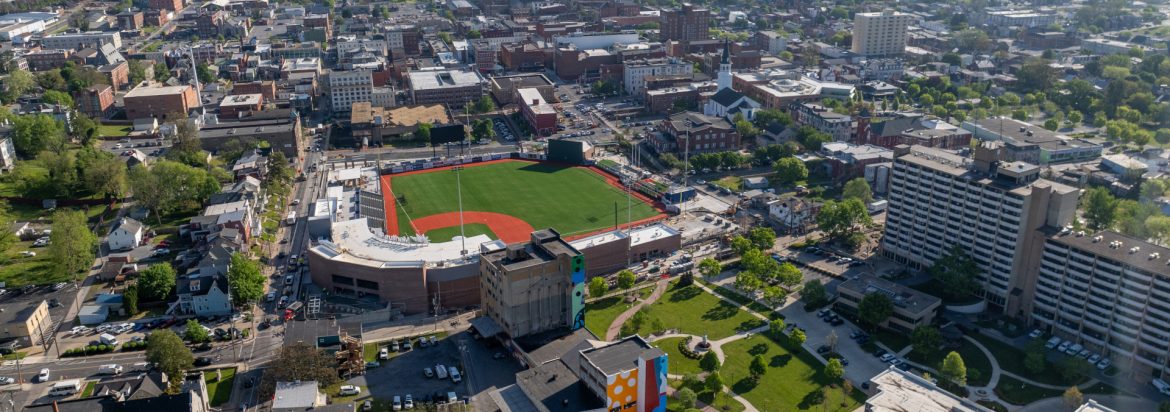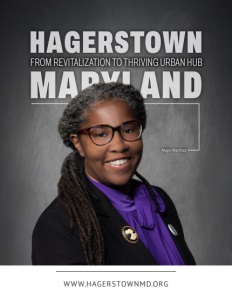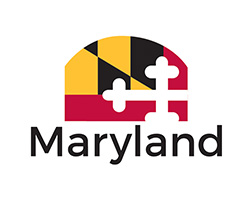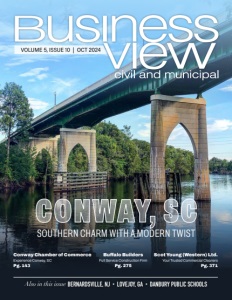Hagerstown, Maryland
From Revitalization to Thriving Urban Hub
Transforming through strategic investments in infrastructure, housing, and sports tourism, the city is poised to become a vibrant destination for residents, visitors, and businesses.
Hagerstown, Maryland, strikes a distinctive balance between small-town charm and the benefits of urban life, making it a unique and increasingly appealing place for both residents and visitors. With a population of around 40,000, the city is often described as a “rural-urban environment,” which encapsulates the ability to move seamlessly between green spaces and urban amenities.
Scott Nicewarner, the city’s administrator, highlights this duality. “We offer access to green space, parkland, and various outdoor amenities,” he says, referencing the abundance of parks and natural areas integral to life in Hagerstown. “But at the same time,” he adds, “we have a very robust urban environment.” That balance of both worlds—the tranquil, nature-filled escape and the buzz of urban activity—has become one of the key aspects that sets Hagerstown apart from its neighbors.
One of the cornerstones of the city’s recent evolution has been the introduction of a new multi-use stadium, which Nicewarner describes as elevating the community to “another level” when it comes to events and entertainment options. The stadium isn’t just a venue; it’s a cultural hub, bringing people together for sports, concerts, and community activities. “It’s something that we can leverage to attract a broader demographic,” he explains, noting that it plays a central role in the city’s efforts to appeal to millennials.
Revitalizing Downtown

Jill Thompson, Director of Community and Economic Development
The revitalization of downtown Hagerstown has been a methodical process driven by a clear vision that combines public investment with strategic planning. Jill Thompson, Director of Community and Economic Development, points to the city’s affiliation with the Main Street program—a national framework that has guided Hagerstown for over 15 years—as the foundation of its downtown efforts.
“We have a ten-year downtown plan that we released in 2014,” she says. As 2024 approaches, the city is preparing to issue a request for proposals (RFP) to update the plan for the next decade, mapping out a continued path for growth that extends to 2034.
Among the transformative projects was the development of the University of Maryland system’s downtown campus and the subsequent creation of the University Plaza. This vibrant public space injects life into the heart of the city. This, along with the construction of the Washington County Free Library—a $23 million LEED-certified project—became early examples of public investment that set the stage for further private development.
One of the more recent undertakings in the downtown improvement efforts has been the urban improvement project, which expanded the Maryland Theatre. This enhanced Hagerstown’s cultural offerings and provided an opportunity to renovate the historic theater, preserving a piece of the city’s architectural heritage while modernizing the space. Thompson also notes the role of education in the city’s resurgence, citing the Barbara Ingram School for the Arts, a public high school that recently expanded to accommodate its growing student body, and the University of Maryland system’s additional building in the area.
Building Infrastructure for Tomorrow
Infrastructure is at the heart of Hagerstown’s ability to support its growing population and evolving economy. Nicewarner explains that Hagerstown has been fortunate in expanding its broadband capabilities.
“We have Antietam Broadband, which has been here a long time, now offering gigabit service,” he says. In addition to this long-standing provider, two more broadband companies, Point Broadband and Comcast, compete to offer high-speed internet across the city. “Comcast is also running fiber throughout town,” he notes, which will increase options and create price competition, benefiting residents.
Beyond broadband, Nicewarner emphasizes the strength of the city’s water system, which serves Hagerstown residents and extends into Washington County and several nearby municipalities.
“We service Smithsburg, Funkstown, and Williamsport,” he points out. The city is revitalizing its transmission mains, a project that will span several years. With the city owning its own water system, the control over quality and pricing remains local—a critical advantage in maintaining the infrastructure necessary for future growth.
Electricity is another key area where the city offers unique services. Hagerstown owns its electric department, although it purchases power wholesale from Potomac Edison rather than generating its own. “Not all city residents have access to city lights due to a boundary created decades ago,” Nicewarner explains. However, the benefits are clear for those who are part of the city’s electric grid. “Our uptime and response time create a great amenity for those within the city that can access it,” he says.
Expanding Residential Options
As housing shortages become an increasingly pressing issue across the country, Hagerstown is tackling the challenge head-on with a wave of residential development projects. Thompson outlines the scope of the city’s ongoing residential projects, emphasizing a significant influx of investment in upper-floor housing.
“We’re seeing about $190 million of new commercial and residential investment in downtown ,” she says, and this includes 182 units being either newly created or renovated downtown alone. Beyond downtown, residential development is happening on an even larger scale across the city. “Almost all available property within the corporate boundaries that are zoned for residential use is in some development phase,” Thompson explains. With roughly 2,000 units in the pipeline, either in the prospecting, planning, or construction stages, Hagerstown is set to experience a significant boost in housing availability.
In addition, the city is working closely with Washington County to develop sites outside the corporate boundaries, further expanding the potential for new housing developments. This partnership with the county broadens the range of options available to developers, ensuring that the housing crunch can be alleviated not only within city limits but also in surrounding areas.
Hub City Brewery
Hagerstown is a hub for arts, culture, and entertainment, and unique venues like Hub City Brewery are pivotal pieces of the city’s broader tourism strategy. “There’s a growing market for breweries, distilleries, and wineries as part of the arts and entertainment offerings,” says Thompson. Hub City Brewery comes to mind for its craft offerings and location.
The brewery purchased the historic city market building from the city, a property that had long been underutilized. “It was a long-standing farmer’s market building that’s now being brought to higher utilization,” she explains. The shift from public to private sector ownership allowed the building to become a tax-generating asset while maintaining its roots in the community. The City’s seasonal weekly farmer’s market continues at an alternative location.
Hub City Brewery will include outdoor programming, with plans to host performances, special events, and outdoor dining in the parking lot space acquired from the city. The brewery’s proximity to the Hagerstown Cultural Trail enhances its appeal as a destination. Patrons can enjoy outdoor entertainment and then stroll along the trail, which leads to City Park, home to the Washington County Museum of Fine Arts (WCMFA). Along the way, visitors will encounter a range of public art installations, turning a casual walk into an immersive cultural experience.
Youth and Workforce Development
As Hagerstown continues to evolve, critical youth programs and workforce training developments create pathways for the next generation of residents while addressing pressing economic needs. Nicewarner highlights the importance of the new Boys and Girls Club of Washington County facility.
The original building, which had served the community for decades, desperately needed an update. Thanks to federal and state funding, the old structure was torn down to create a modern, state-of-the-art center offering a broad range of programs for Hagerstown’s youth.
On the workforce development front, the D.M. Bowman Family Workforce Training Center is another game-changing addition to Hagerstown. Located on Northern Avenue, this Hagerstown Community College facility addresses the growing need for skills training and education in response to labor shortages. “This center is about making education accessible,” Nicewarner says, pointing out that not just city residents but individuals across the broader regional area will benefit.
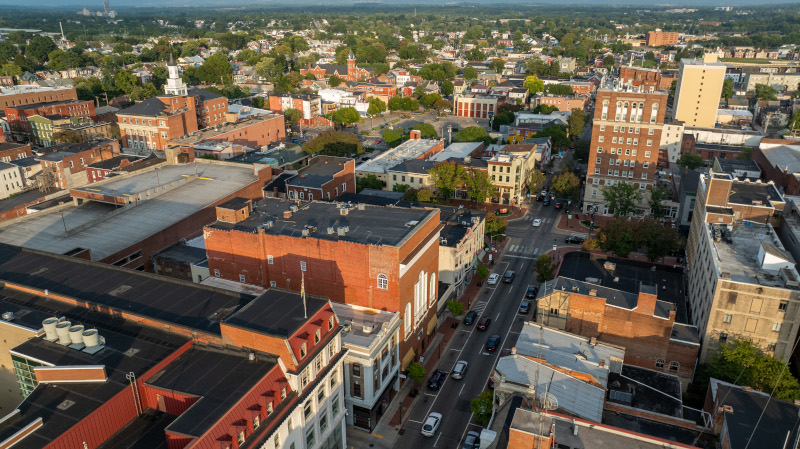
Sports Tourism
Hagerstown’s vision for sports tourism has rapidly materialized, transforming the city into a destination for regional and national tournaments. Nicewarner outlines the city’s long-term vision for its sports tourism sector, pointing to the thousands of visitors drawn annually to Fairgrounds Park for softball and soccer tournaments.
“On a spring or summer day, you can see a thousand people playing in tournaments at Fairgrounds Park or City Park,” he says. The city has aimed to create a seamless experience where visitors can spend their days on the fields and their evenings exploring Hagerstown’s cultural offerings. “In the evening, people can head over to Meritus Park for a ball game or a concert,” he adds, noting how the city’s arts and entertainment district offers an ideal complement to its sports facilities.
The Hagerstown Field House, which will be completed by January 2025, is a key part of this vision. The structure, which will soon host volleyball, basketball, and soccer tournaments, among other events, represents the city’s ongoing investment in building infrastructure to support residents and the influx of visitors for sports events. “We just had a topping-off ceremony for the last beam,” Nicewarner says, describing the pride and excitement of watching this long-awaited project come together.
“The new construction is going to add to what Jill mentioned—it’s not just an amenity for our youth but also an attraction for outside groups to come in and participate in youth sports and other activities,” he explains.
Hub City Garage
In a city that’s rapidly growing in population and attractions, managing traffic and parking is essential to maintaining ease of movement for residents and visitors. Hagerstown’s latest infrastructure investment, the $12 million Hub City Garage, is poised to play a key role in addressing those needs while enhancing the city’s overall walkability.
“It is our third parking deck downtown,” Nicewarner explains, “and it opened in early August.” Conveniently located across from the ballpark, the new garage will cater to event attendees, providing easy access for fans and tourists. He emphasizes that the facility also plays a central role in Hagerstown’s push to make the downtown more pedestrian-friendly.
“You can pretty much do anything you need to do within a short walk,” he says. The new garage and existing parking infrastructure support this vision by offering convenient parking options within a few blocks of key destinations, whether it’s the ballpark, arts district, or downtown businesses.
Collaboration: The Foundation of Hagerstown’s Growth
Hagerstown has not achieved its success in isolation. The intricate dance of urban development, revitalization, and addressing community needs is a collective effort, relying heavily on partnerships across government, business, and community groups. Nicewarner acknowledges the invaluable role of partnerships in the city’s growth.
“We appreciate the support we get from our state and federal delegation,” he says, highlighting how essential this backing has been for securing funding for major projects. Key partnerships go beyond government assistance, though. “The Bowman family and partners within the Greater Hagerstown Committee are instrumental in providing feedback and partnering on several projects,” he explains.
Collaboration with local entities, like the Chamber of Commerce and county government, also remains vital to ensuring Hagerstown’s growth benefits the entire region. “What’s good for Hagerstown is good for Washington County, and it’s good for the four-state region that we live in,” Nicewarner points out. This mutual benefit approach is the guiding principle behind many city development decisions.
Nicewarner is also transparent about the realities of urban growth and the challenges that come with it. “It’s not all sunshine and roses every day here in Hagerstown,” he admits, acknowledging the difficulties many regional municipalities face. However, the city’s progressive approach and supportive elected officials allow Hagerstown to mitigate challenges and expand its offerings.
Hagerstown’s Next Chapter
Hagerstown’s continued evolution will hinge on the city’s preparedness for the challenges and opportunities ahead, while focusing on sustaining and building upon the progress made thus far. Thompson sees the city moving into a new phase of development.
“I think we’ll soon shift from redeveloping downtown to managing the success of that redevelopment,” she says, hinting at a future where the city’s primary focus will be maintaining the vibrancy and vitality the revitalization efforts have brought.
Nicewarner echoes Thompson’s sentiments but adds that one of the city’s biggest challenges will be modernizing its older structures. “The challenge is making an old city new,” he explains. Much of Hagerstown’s charm lies in its historic architecture, but ensuring those buildings can be adapted into modern amenities is crucial to attracting people to live, work, and play downtown.
The housing crisis remains a key issue for Hagerstown, as it does across much of the country. Nicewarner acknowledges the pressure but feels optimistic about the city’s approach. “We feel good about the strategies we’ve implemented to create residential development,” he says, noting that the city has made significant strides since the end of the pandemic.
The newly opened multi-use stadium is another significant success. At the close of the 2024 baseball season and after 60 home games, Meritus Park attracted more than 175,000 fans with a game average of nearly 3,000 attendees. “The ballpark is also hosting many events beyond baseball,” Nicewarner shares, emphasizing its role in showcasing Hagerstown’s revitalized downtown. “The future is about keeping people coming back.” These and other projects highlight Hagerstown’s ambition to accommodate and encourage the expansion that city leaders believe is on the horizon.
AT A GLANCE
Hagerstown, Maryland
What: A city undergoing revitalization with investments in infrastructure, housing, and sports tourism
Where: Washington County, Maryland
Website: https://www.hagerstownmd.org/
PREFERRED VENDORS
Jones Lang LaSalle IP, Inc. – https://www.us.jll.com/
The JLL Mid-Atlantic Industrial Team harnesses the scale of our platform to provide insights, results and opportunities for our clients in the commercial real estate arena. We deliver unparalleled value through teamwork and collaboration.
Washington County Museum of Fine Arts (WCMFA) – https://wcmfa.org/
Washington County Museum of Fine Arts in Hagerstown, Maryland, offers exposure to a world-class collection without a trip to a big city. Nestled in beautiful City Park, the museum features special exhibitions, concerts, lectures, community events, and art classes. Since 1931, the museum has offered free admission and parking.
